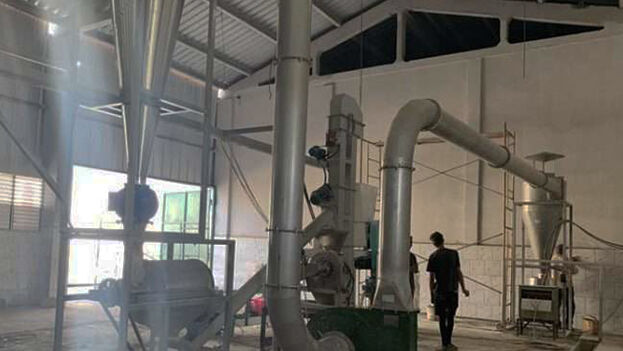
![]() 14ymedio, Havana, 9 February 2023 — The Ceiba Citrus Company, located in Caimito, Artemisa, has bet all its cards on the construction of a new cassava flour factory. However, despite the investment required by the plant, its managers cannot guarantee that the harvest of the tuber on the Island will live up to their expectations.
14ymedio, Havana, 9 February 2023 — The Ceiba Citrus Company, located in Caimito, Artemisa, has bet all its cards on the construction of a new cassava flour factory. However, despite the investment required by the plant, its managers cannot guarantee that the harvest of the tuber on the Island will live up to their expectations.
Alejandro Valdés, general director of the factory, told the provincial newspaper El Artemiseño that they are working “without rest” in the assembly of the machinery, with an initial production capacity of 440 to 2,645 pounds per day. In full operation, the manager said, the technology will allow obtaining one ton of flour for every two of fresh cassava.
The operation will require a stable supply of the tuber and, although the amount required for the premiere of the factory is assured, Ceiba does not have guarantees that the national production of cassava can keep up with it. Within a year, at least the planting of 740 acres will be required to maintain the industry, with a yield of between 16 and 20 tons per acre.
The machinery is a donation from the Sustainable Agriculture Support Project (PAAS), implemented with the support of the Swiss Development Agency and the Dutch NGO Hivos, dedicated to strengthening agricultural production on the Island. Valdés said that since June last year they have been “immersed” in the assembly, but acknowledged that there were delays because they did not have the “relevant capacity” to handle the technology, which has led to “variations throughout the process and has been a very useful learning process.”
The shortage of materials has made it difficult to meet the deadlines, added Orestes Leiva, administrator of the new industry, who expects the plant to be ready between February 15 and 20, if the entry of materials remains stable.
Valdés explained that the machines will cover the entire process, from the transport of the cassava to its cleaning in a tank where some blades will remove its skin. Then, it will be moved to a grinder and dried in an oven at about 400 degrees, in order to finally grind and pack the flour.
Cassava derivatives have served as an alternative to the scarcity and increase in the price of wheat and other cereals on the Island, mainly for the preparation of bread that is distributed in the ’normal family basket’ [through the rationing system]. Its high starch content makes it a healthy food. It’s also used by industries for pharmaceuticals and cosmetics, and can even be used to replace malt in beers.
However, its use in baking has not achieved popular acceptance, which points to breads made with a mixture of the tuber and wheat flour as less durable, with a darker dough and variations in flavor. For most consumers, the use of cassava for these purposes results in a lower quality food.
Sergio Rodríguez Morales, director of the National Institute of Tropical Food Research (Inivit) of the Ministry of Agriculture, told the official newspaper Granma that the cultivation of cassava has had several “significant advances” but insisted that it falls short in meeting the demand for human, animal and industrial consumption.
Currently, Cuba has about 111,000 cultivated hectares of cassava, the highest area in history, although the goal of the Ministry of Agriculture is to reach 494,210 acres in the “shortest possible period,” the technician said.
The article in Granma, published last November, refers to the fact that producers see more profitable income in the cassava with the sale of 220 pounds at 350 pesos. Raidel García, a farmer from Camajuaní, considers it a plant that is “irreplaceable in current times” because it is harvested throughout the year and survives without irrigation and application of fertilizers.
Translated by Regina Anavy
____________
COLLABORATE WITH OUR WORK: The 14ymedio team is committed to practicing serious journalism that reflects Cuba’s reality in all its depth. Thank you for joining us on this long journey. We invite you to continue supporting us by becoming a member of 14ymedio now. Together we can continue transforming journalism in Cuba.
